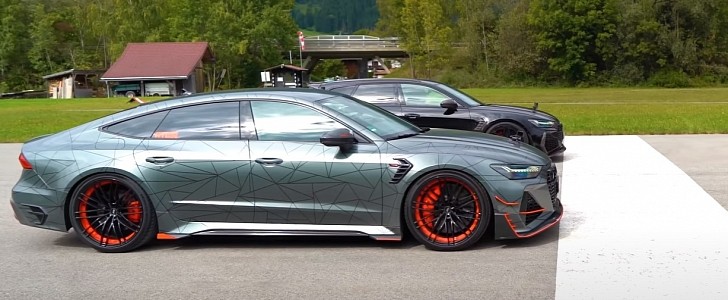OK, so you know the combined power of these two cars is 1,600 hp; what you don't know is how that pretty impressive amount of power is split between the two ABT-tuned Audis.
Well, the answer is "straight down the middle". The two cars share the same powertrain and the same tuning package, which means the 592 hp (600 PS) the 4.0-liter twin-turbo V8 engine makes when stock has now been bumped to a much meatier 800 hp. Considering what the competition is doing –Mercedes-AMG with the GT 63 S E Performance or BMW with the M5 CS – that's pretty much the bare minimum of what these two models should be making as they exit the factory. However, as long as we're not members of the Audi board, our opinion is largely (completely?) irrelevant.
Glancing over the specs of these two cars, it's almost scary to see just how evenly matched they are. The only thing separating them is ten kilograms (22 lbs) – with the RS 6 station wagon being the heavier of the two – and the price. Frankly, neither of these is going to have any impact on their performance on the track, so if anything is going to separate between them, it'll have to be either the aerodynamics or the drivers' skill.
Well, with modern cars featuring automatic transmissions and launch control systems, the only influence a driver can have on the outcome is their reaction time. Judging by how close all of these races are – you could almost plank between the two Audis throughout the entire length of the quarter mile – and even according to our eye measurements, the two drivers had similar reflexes.
That leaves the aerodynamics of the two cars as the sole differentiator, though we could be looking at a few other minor aspects as well – tires, the fuel level in the tank, gasoline quality. When the margins are this small (0.13 seconds in the first race and 0.18 in the second), you can start looking into anything – even what the two drivers had for breakfast.
This is the closest you can get to racing two identical cars without actually doing that, which is probably what makes it still relevant and interesting. However, as far as we're concerned, the RS 6 is the clear winner – if 0.15 seconds (we've averaged the two results) over the quarter mile is the price we have to pay to have all the practicality (not to mention the cool presence) of the station wagon, we can definitely skip on the RS 7.
Glancing over the specs of these two cars, it's almost scary to see just how evenly matched they are. The only thing separating them is ten kilograms (22 lbs) – with the RS 6 station wagon being the heavier of the two – and the price. Frankly, neither of these is going to have any impact on their performance on the track, so if anything is going to separate between them, it'll have to be either the aerodynamics or the drivers' skill.
Well, with modern cars featuring automatic transmissions and launch control systems, the only influence a driver can have on the outcome is their reaction time. Judging by how close all of these races are – you could almost plank between the two Audis throughout the entire length of the quarter mile – and even according to our eye measurements, the two drivers had similar reflexes.
That leaves the aerodynamics of the two cars as the sole differentiator, though we could be looking at a few other minor aspects as well – tires, the fuel level in the tank, gasoline quality. When the margins are this small (0.13 seconds in the first race and 0.18 in the second), you can start looking into anything – even what the two drivers had for breakfast.
This is the closest you can get to racing two identical cars without actually doing that, which is probably what makes it still relevant and interesting. However, as far as we're concerned, the RS 6 is the clear winner – if 0.15 seconds (we've averaged the two results) over the quarter mile is the price we have to pay to have all the practicality (not to mention the cool presence) of the station wagon, we can definitely skip on the RS 7.














